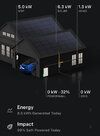bradtem
Robocar consultant
Do you have net metering? If so, there is not much merit it working too hard on making sure your car only charges when the solar panels have a surplus. In the future, there might be, when we get to having so much solar on the grid that the grid refuses to take more, but that's not now.
If you don't have net metering, then this can be a financial win, though there's no emissions difference. If you are grid tied, your solar panels are just part of the grid's generation ability, and your car part of its load. There's a very minor increase in efficiency if you time it in this way.
The bad news is this. No matter how much solar you have, every mile you drive in your car causes the grid to burn more dirty fuel. Even if you generate 10x as much power from your panels, when you charge your car you send less power to the grid, and so the grid now needs to burn more fossil. Drive your car less, and your panels send more power to the grid, and it burns less fossil. Almost exactly the same as if you had no panels at all!
The best you can do (and I do it) is contract so that your money for grid electricity only comes from renewable providers. I do that, not all places allow it. In that case, the money you send to the grid will encourage the addition of renewable sources more.
This is just the hard math. Putting in panels is good, and improves the grid. The pairing with your car is unrelated. If you don't have net metering, there's a big financial gain to using your own generated energy though.
If you don't have net metering, then this can be a financial win, though there's no emissions difference. If you are grid tied, your solar panels are just part of the grid's generation ability, and your car part of its load. There's a very minor increase in efficiency if you time it in this way.
The bad news is this. No matter how much solar you have, every mile you drive in your car causes the grid to burn more dirty fuel. Even if you generate 10x as much power from your panels, when you charge your car you send less power to the grid, and so the grid now needs to burn more fossil. Drive your car less, and your panels send more power to the grid, and it burns less fossil. Almost exactly the same as if you had no panels at all!
The best you can do (and I do it) is contract so that your money for grid electricity only comes from renewable providers. I do that, not all places allow it. In that case, the money you send to the grid will encourage the addition of renewable sources more.
This is just the hard math. Putting in panels is good, and improves the grid. The pairing with your car is unrelated. If you don't have net metering, there's a big financial gain to using your own generated energy though.



